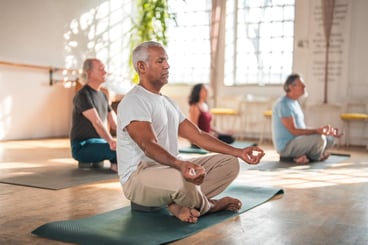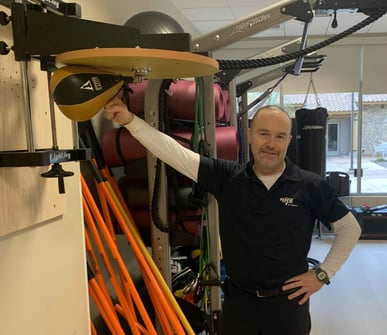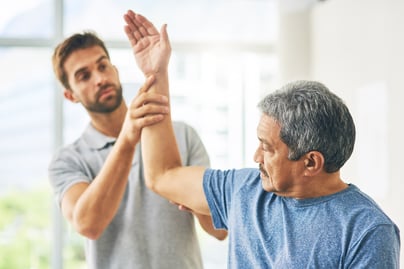 Regular exercise is incredibly beneficial for people with Parkinson’s disease (PD). It helps manage symptoms like stiffness, gait issues, posture, and balance deficiencies. Individual exercises can build into complex movement patterns, eventually evolving into activities such as dancing, yoga, and boxing. Since PD presents itself uniquely in each person, no two exercise programs will look the same. A personalized plan that takes into account both the individual’s daily needs and the activities they enjoy most will have the greatest impact on improving their quality of life.
Regular exercise is incredibly beneficial for people with Parkinson’s disease (PD). It helps manage symptoms like stiffness, gait issues, posture, and balance deficiencies. Individual exercises can build into complex movement patterns, eventually evolving into activities such as dancing, yoga, and boxing. Since PD presents itself uniquely in each person, no two exercise programs will look the same. A personalized plan that takes into account both the individual’s daily needs and the activities they enjoy most will have the greatest impact on improving their quality of life.
Guidelines for a Parkinson’s-specific program recommend three 30-minute sessions per week that include cardiovascular work, strength training, and a preferred activity (yoga, boxing, tai chi, etc.). Training balance, posture, and flexibility should happen daily if possible. Cardiovascular exercise enhances motor function and cognitive abilities, while strength training slows disease progression and improves dopamine efficiency in the brain. Regular balance, posture, and flexibility work promotes better mobility, and a person’s favorite activity helps them apply these skills in a fun and challenging way.
Do it for the moves and the mood! Getting heart rates into the target zone (50-80% of maximum) has been shown to improve executive function, speed of processing, and memory. High-intensity exercise can slow neurodegeneration and, in many cases, even reverse the effects of PD. Cardiovascular exercise can be done with cardio equipment, but it can also be combined with balance, strength, and reflexive movements found in activities like dancing, boxing, or ping pong. This creates a combination of benefits that also boosts mood.
Do it big and with gusto! High-energy movements, challenging sequences, and the ability to adapt in real-time are key. But make room for proper rest and resets throughout. It's important to celebrate achievements along the way and remember—there are no mistakes for someone with Parkinson’s, only opportunities to adjust and discover new ways to move. The brain is always rerouting itself through neuroplasticity.
Movement, sleep, and repair go hand in hand. Exercising regularly in the described style promotes better sleep, allowing the body to repair itself. This includes clearing away brain accumulations, releasing growth hormones to build strength, and reinforcing learning that leads to greater movement efficacy and confidence. Understanding the connection between exercise, sleep, and repair is crucial. Adding an evening ritual of breathwork and flexibility exercises can help maximize the benefits of movement and improve overall wellbeing.
Step up for a cause! Join us Thursday, April 10, for Pump It for Parkinson’s. Together, we can reach 25 million steps in support of those living with Parkinson’s disease. Don’t miss out—register today and help us make a difference!


 Acute and chronic pain is something almost everyone must deal with in their lifetime whether it is from an injury, overuse, or a degenerative condition such as arthritis. This consideration becomes much more common as exercisers move into the active aging portion of their fitness journey. Meditation in various forms has been shown to provide relief in both acute and chronic situations and in many cases may increase an exerciser’s overall pain tolerance. Techniques that correlate well with pain management are mindfulness meditation, body scans, visualization, guided meditation, and progressive muscle relaxation.
Acute and chronic pain is something almost everyone must deal with in their lifetime whether it is from an injury, overuse, or a degenerative condition such as arthritis. This consideration becomes much more common as exercisers move into the active aging portion of their fitness journey. Meditation in various forms has been shown to provide relief in both acute and chronic situations and in many cases may increase an exerciser’s overall pain tolerance. Techniques that correlate well with pain management are mindfulness meditation, body scans, visualization, guided meditation, and progressive muscle relaxation.
 Training elements from boxing have become very popular in the active aging segment of the population so it stands to reason that it would be a great training element to include in a senior living fitness program. The benefits when done correctly are immense and include
Training elements from boxing have become very popular in the active aging segment of the population so it stands to reason that it would be a great training element to include in a senior living fitness program. The benefits when done correctly are immense and include 
 Arthritis is an increasingly common condition that refers to 100 different types of diseases, affects all age groups and affects 1 in 4 adults, equating to 80 million people in the United States. The most common form seen is osteoarthritis or degenerative joint d
Arthritis is an increasingly common condition that refers to 100 different types of diseases, affects all age groups and affects 1 in 4 adults, equating to 80 million people in the United States. The most common form seen is osteoarthritis or degenerative joint d